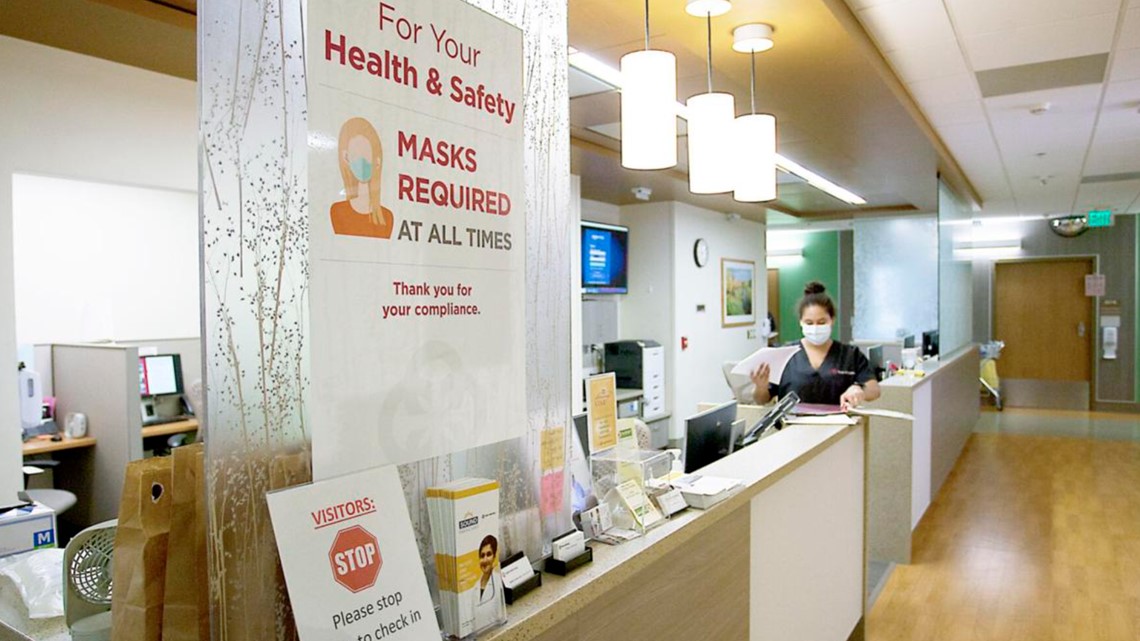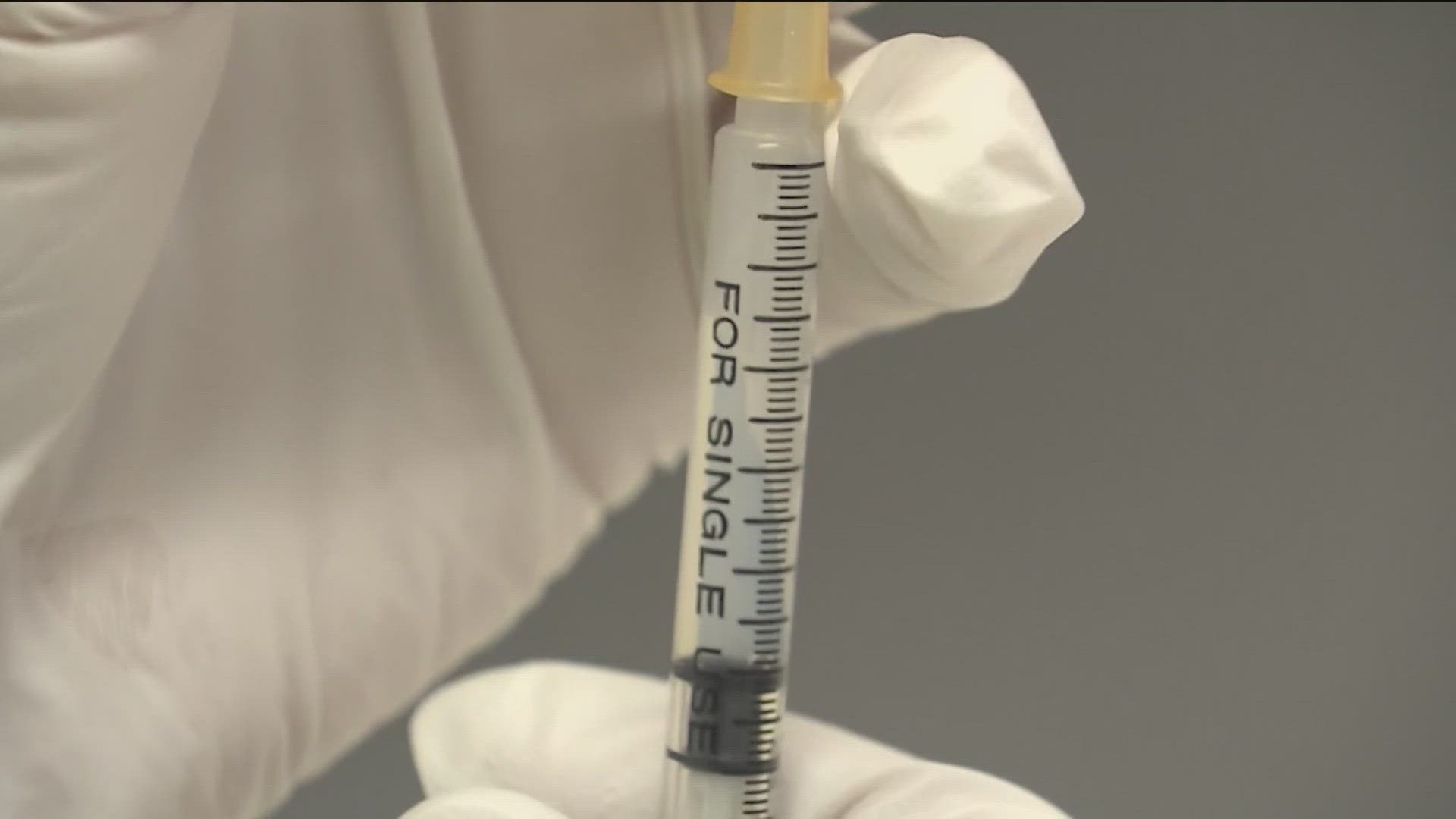NAMPA, Idaho — Joshua Holweger will never forget the two teenage boys crying over the dead body of their 47-year-old father.
This situation is not unique. COVID-19 cases are surging in Idaho and so are deaths, with over 150 reported in September alone. The families who lose loved ones have to say goodbye in a way they never imagined, and health care workers are there to witness it all.
“I got into this to save people,” said Holweger, a doctor of pulmonary and critical care at Saint Alphonsus Medical Center-Nampa. “And on a daily basis I'm getting to watch people die and it’s awful.”
On Thursday evening, Holweger stood in front of the facility's ICU patient census board which showed 11 patients actively had COVID-19. There were two beds open.
Tanya Lawson, Director of Nursing, pointed at one of the patients on the census. That patient used to have COVID, she said, but had been discharged and then re-admitted.
“Oh jeez,” Holweger said, taking off his glasses. “I don’t remember that. They all start to run together because they’re all the same thing. It’s everyone with the same thing.”
Idaho’s COVID-19 surge is dramatically affecting health care workers on the front lines. They have PTSD. They cry in their car on the way home from work and try to wipe the tears off before going inside, said ICU Charge Nurse Brandi Eis. They don’t want to talk about what they’ve experienced with people who do not understand.
Unlike early 2020, few are rallying around the health care community, which is facing higher hospitalizations than ever before. A long hallway lined with rooms in the Nampa ICU looks out onto a window showing blue sky and the mountains in the distance. Inside, workers are fighting a “hospital battle,” Eis said. And Canyon County is quickly becoming a hotspot.
CANYON COUNTY'S COVID SURGE
At least one in seven residents in Canyon County has been infected with COVID-19, with at least 2,300 cases reported so far this month. Canyon County had the highest number of cases in the state for the weeks ending Sept. 11 and Sept. 18, after several weeks of Ada County at the top.
In Canyon County, only 33% of all residents are fully vaccinated, compared to the nationwide rate of 54%. Only 74% of people 65 and older are fully vaccinated in Canyon County, compared to the nationwide rate of 83%.
The COVID-19 vaccines protect against severe illness, hospitalization and death, medical professionals have repeatedly stated. Around 90% to 95% of patients who have COVID-19 in Saint Alphonsus ICUs are unvaccinated.
At this point, attending indoor activities in Canyon County is “extremely dangerous,” according to the New York Times, and even outdoor events are not safe. But many local residents are largely going about their lives, unmasked and unprotected. Venues like the Ford Idaho Center are hosting concerts and other events.
To make matters more difficult, some politicians are spreading disinformation, Saint Alphonsus Medical Center-Nampa President Travis Leach said.
“Our political leaders are not only not supporting us, they're actively supporting misinformation,” Leach said. “We have local Canyon County people that are actively spending their time focused on telling people that they should have a choice, which I agree with choice, but they're not telling people how serious this pandemic is and people are dying as a result.”
Over half of all patients in the Nampa hospital had COVID-19 on Thursday, Lawson said. Initially, the hospital kept COVID-19 patients in the ICU, but the hospital has overflowed to their telemetry unit and their med surge unit. In the past couple of weeks, the hospital has moved patients to telemetry who before would have normally only been at the ICU level.
Though Idaho enacted statewide crisis standards of care on Thursday, Saint Alphonsus Medical Center-Nampa is not implementing those measures at this time.
Nearly a year-and-a-half into the pandemic, the patients are now younger, hospital staff said. One such patient was in the prone position in their room on a ventilator, lying on their stomach with electrodes on their back. A small tattoo snaked around their ankle.
Back down the hallway, another patient was proned and on a ventilator. They were sedated to make sure it was comfortable and were on pain meds. They had a tube going through their nose into their stomach to feed them and provide water.
Once a patient needs to be intubated, Holweger will put them on their stomach and paralyze the patient to dial in the ventilator. For the first 24 hours, the patient is heavily sedated. On a daily basis, patients are put on their backs to see how they do. If they need to go on their stomach, they go for six hours on their back and then onto their stomach.
When a patient's breathing is poor enough, the staff doesn't let them eat or drink because breathing takes precedence.


MORAL INJURY
At first, many COVID-19 patients often start off on very little oxygen. Then, they slowly need more. They get short of breath. They start breathing faster. They start realizing they are in trouble.
Patients are hesitant when doctors recommend intubation. They refuse for days, until it’s a matter of intubation or death. It makes it dangerous for them to wait that long because their oxygen levels can drop dangerously low, Holweger said.
Staff will tell them to call their families and say goodbye.
“We pull up their phones and we tell them to Zoom their whole family and say, ‘You need to tell her you love her because you may never speak to her again,’” Eis said. “They're out of breath, they can’t speak and because (they’ve waited) so long to let us intubate them, they now can’t even tell their loved ones goodbye and it’s heartbreaking. And we see it every day.”
Most patients die on a ventilator, instead of on comfort care. If families request a chaplain or last rites, the hospital will arrange for those requests.
Only two visitors are allowed and they can’t switch out, because the hospital has to limit exposure.
“If you have a wife and two children, one of them gets to sit in the parking lot,” Eis said. ”So somebody gets to sit in the car while their husband or loved one or father dies, while the other two (are) here. And that's heartbreaking as well, to turn families away from their loved ones.”
If a father has five children, the family has to choose which two can go.
It takes a toll on hospital staff as well. Enforcing the visitor limit is a “moral injury,” Eis and Lawson said, as is not having the time to update families on their loved ones due to being stretched thin.
The measures hospitals are implementing to deal with the pandemic also take a lot of humanity out of the patient's experiences.
Patients can only see eyeballs of staff and can’t really hear them. Eis used to be able to hold the hands of her patients when they died, and now that human touch is gone.
“It can be very confusing for patients sometimes, because if you’re sick, your brain disorganizes and you’re not seeing faces anymore, you’re seeing masked people and it makes patients scared,” Holweger said.
STRAINING THE HOSPITALS
In 2009, with the swine flu, patients would come in very sick for a couple days and then they would die, Holweger said. Now, hospital staff can keep people alive but are not able to get them over the hill. The ventilators are meant to be a bridge to something else, but many patients are just stuck on them. Part of the problem is this process backs up the health care system with people in the ICU for weeks.
It’s hard to describe where the line is, but at some point, the staff isn’t prolonging someone’s life anymore, they’re just prolonging the dying process, Holweger said.
“That’s the hell of it,” he said. “They stay around for so long, just slowly dying in front of you.”
Facts not fear: More on coronavirus
See our latest updates in our YouTube playlist:



